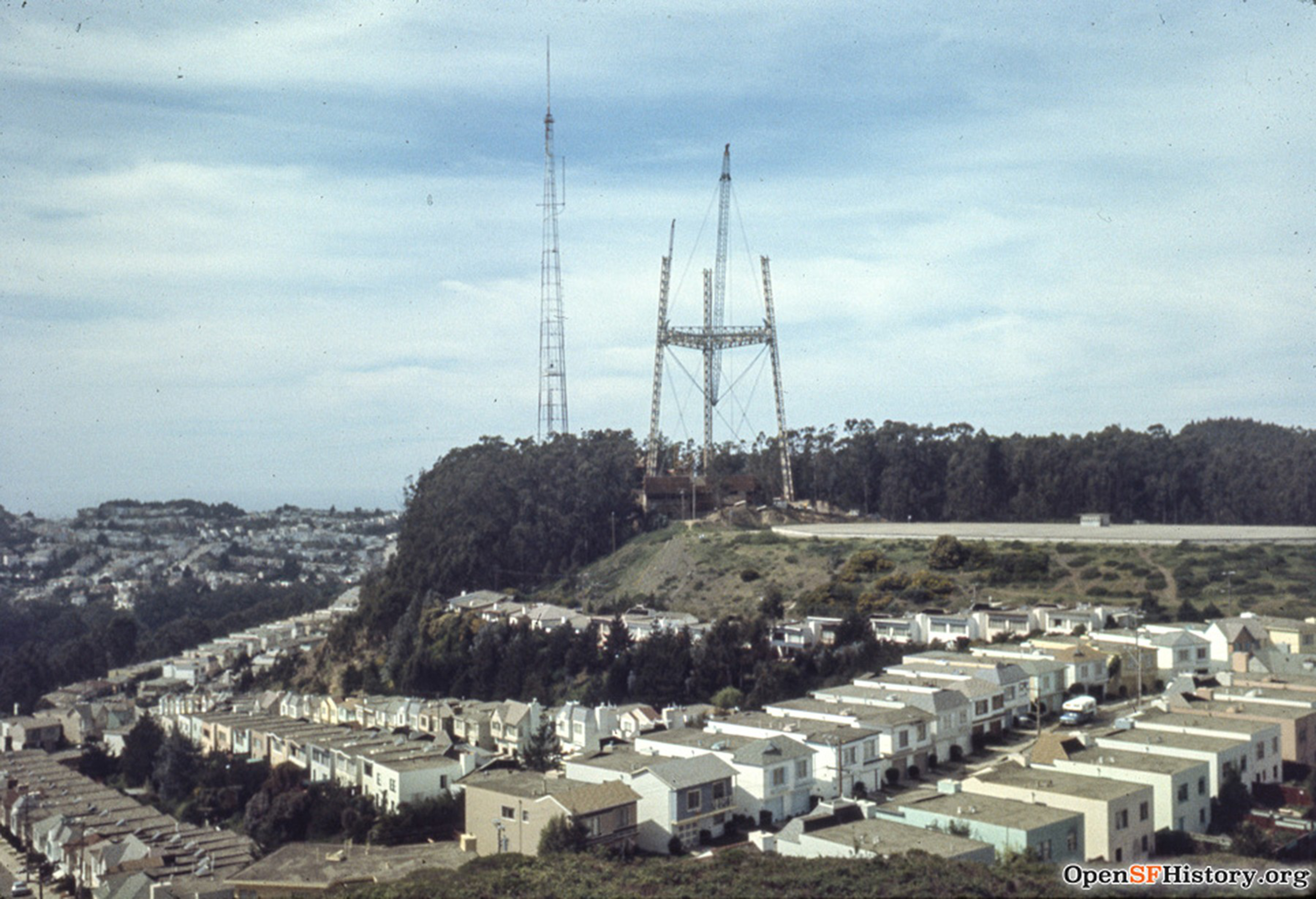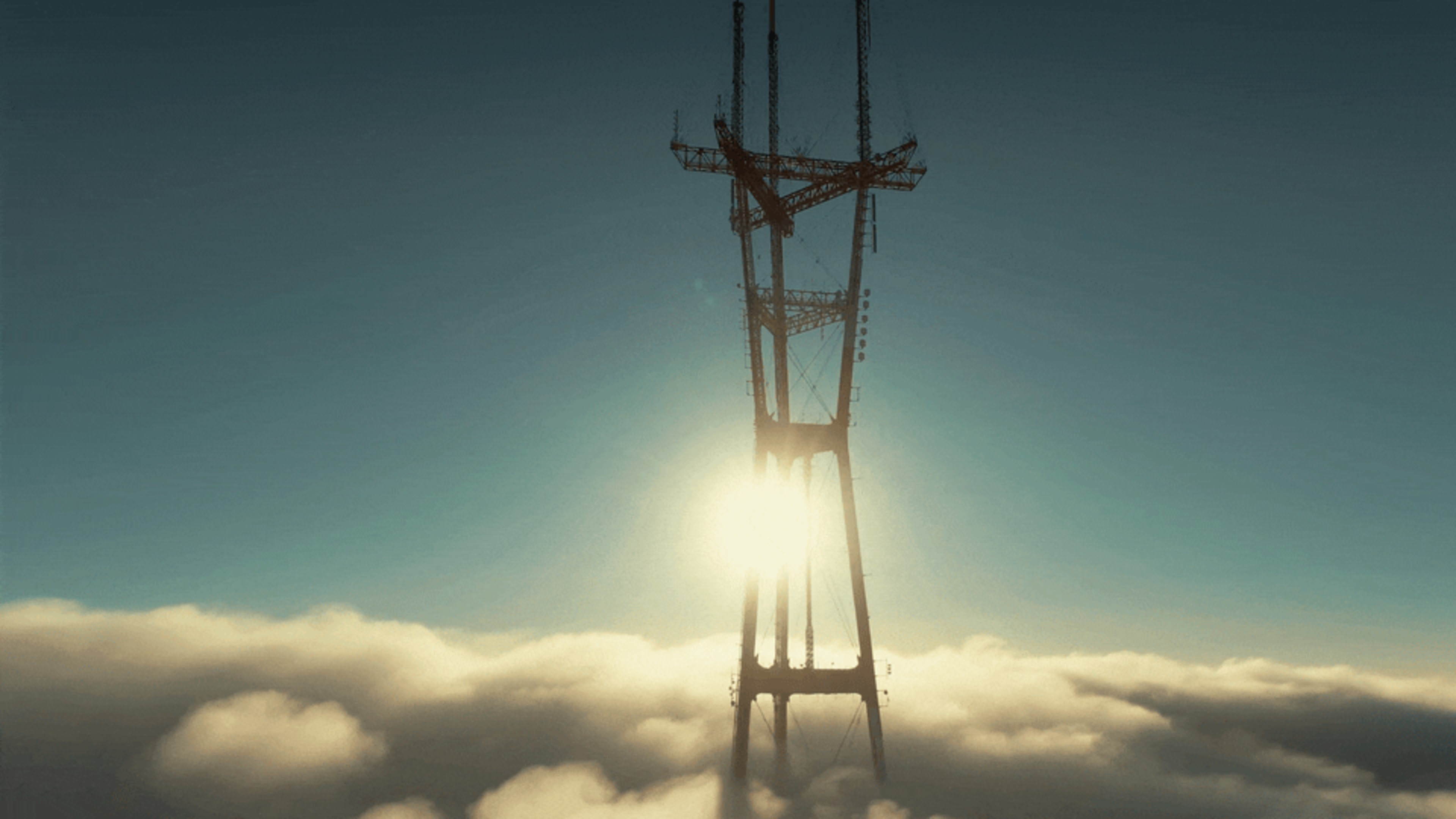Nationally, the Fourth of July may mark the United States’ official adoption of the Declaration of Independence. But here in San Francisco, the date has taken on additional significance in the past 50 years. On July 4, 1973, Sutro Tower began beaming TV and radio signals out to the city and wider Bay Area.
The 977-foot-high broadcast tower situated atop Mount Sutro is an integral part of San Francisco’s infrastructure. Serving more than 1 million people (opens in new tab), the tower transmits signals for 10 television stations and three FM radio stations, along with wireless and mobile communications for taxi dispatchers, emergency responders and law enforcement all over the bay.
Once considered an eyesore (opens in new tab), the iconic landmark has aged well. It is now firmly enmeshed in the city’s pop culture landscape—and has inspired everything from cheeky Twitter accounts to artistic homages—including an exhibition of creative Sutro Tower tributes at RVCA SF Gallery (opens in new tab), which opened Friday and runs through the end of July.
In the meantime, you can read up on Sutro Tower’s quirky history in honor of the landmark’s 50th birthday.
Sutro Tower Fast Facts
- Sutro Tower is 977 feet tall. Its highest antennas are 1,811 feet above sea level.
- The tower’s three legs are embedded in 15 million pounds of concrete.
- The tower is made of 3.5 million pounds of steel.
- The tower’s colors are white and “aviation orange.”
A Media War Birthed Sutro Tower
Back in the ’60s, the San Francisco Chronicle was in a bitter battle (opens in new tab) with the American Broadcasting Company because the Chronicle wanted to build a transmission tower for its station KRON on San Bruno Mountain, while ABC wanted to build a transmission tower on Mount Sutro, where it owned land.
Ultimately, the Federal Aviation Authority rejected the Chronicle’s proposal to build on San Bruno because the location was too close to the airport, according to a history of Sutro Tower by KQED (opens in new tab). The San Francisco Board of Supervisors voted 6-4 against building a tower at Mount Sutro, but it was not enough votes to stop the tower from breaking ground in 1969.
A Space Needle Twin?
To some, Sutro Tower bares a resemblance to the Space Needle in Seattle (opens in new tab). That might not be a coincidence. Early design renderings of Sutro Tower (opens in new tab) have been compared to the iconic West Coast observation tower, and Sutro Tower’s original structural engineer, Furman Anderson, may have been influenced by the Space Needle, according to reporting by the Chronicle (opens in new tab). So do you think that the Space Needle and Sutro look like siblings?

A ‘Haunted Mansion’ Once Stood at the Foot of Sutro Tower
Did you know that a spooky-looking—and some might say “haunted”—mansion once stood at the base of the giant antenna holder (opens in new tab)? In 1930, Adolph Gilbert Sutro, the grandson of famed San Francisco Mayor Adolph Sutro, decided to build a $250,000 residence directly beneath where the tower now stands, according to a history of the site by KQED (opens in new tab). The three-story house with stained glass windows, turrets and spider-web motifs was called La Avanzada. So what happened to it?

In 1948, Adolph G. Sutro sold the property to ABC for $125,000 (opens in new tab), and the broadcasting company built a smaller predecessor to today’s Sutro Tower for KGO-TV, which stood at around 500 feet tall. The house was used as an “auxiliary studio for live telecasts,” and staff members took to calling Sutro’s former abode “the haunted mansion,” even comparing it to Dracula’s castle (opens in new tab). When construction crews broke ground on Sutro Tower in 1969, Sutro Jr.’s ex-mansion was deemed an eyesore and a fire hazard and torn down.
A Restaurant Was in the Works … Sort Of
For years, rumors swirled that a restaurant was planned for the top of Sutro Tower. But in 2021, the Chronicle found the root of the pie-in-the-sky idea (opens in new tab).

During the media war over Sutro Tower, the Chronicle published a news story in 1962 floating the idea that a TV tower at San Bruno Mountain could become a tourist destination with a restaurant. But that was not to be.
The Tower Used To Wail Like a Harp
After finishing the tower in 1973, engineers added girders and a network of cables to keep the structure’s antennas from swaying. Unfortunately, when the wind would rush through, the whole tower would moan like a harp (opens in new tab), according to reporting by KQED. A redesign of the cables quieted the loud sound.
